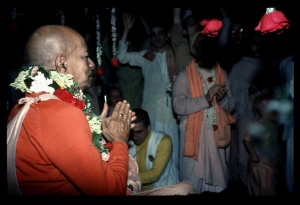CC Madhya 25.114 (1975): Difference between revisions
(Vanibot #0027: CCMirror - Mirror CC's 1996 edition to form a basis for 1975) |
(Vanibot #0020: VersionCompareLinker - added a link to the Version Compare feature) |
||
| Line 2: | Line 2: | ||
<div style="float:left">'''[[Sri Caitanya-caritamrta (1975)|Śrī Caitanya-caritāmṛta (1975)]] - [[CC Madhya (1975)|Madhya-līlā]] - [[CC Madhya 25 (1975)|Chapter 25: How All the Residents of Vārāṇasī Became Vaiṣṇavas]]'''</div> | <div style="float:left">'''[[Sri Caitanya-caritamrta (1975)|Śrī Caitanya-caritāmṛta (1975)]] - [[CC Madhya (1975)|Madhya-līlā]] - [[CC Madhya 25 (1975)|Chapter 25: How All the Residents of Vārāṇasī Became Vaiṣṇavas]]'''</div> | ||
<div style="float:right">[[File:Go-previous.png|link=CC Madhya 25.113 (1975)|Madhya-līlā 25.113]] '''[[CC Madhya 25.113 (1975)|Madhya-līlā 25.113]] - [[CC Madhya 25.115 (1975)|Madhya-līlā 25.115]]''' [[File:Go-next.png|link=CC Madhya 25.115 (1975)|Madhya-līlā 25.115]]</div> | <div style="float:right">[[File:Go-previous.png|link=CC Madhya 25.113 (1975)|Madhya-līlā 25.113]] '''[[CC Madhya 25.113 (1975)|Madhya-līlā 25.113]] - [[CC Madhya 25.115 (1975)|Madhya-līlā 25.115]]''' [[File:Go-next.png|link=CC Madhya 25.115 (1975)|Madhya-līlā 25.115]]</div> | ||
{{CompareVersions|CC|Madhya 25.114|CC 1975|CC 1996}} | |||
{{RandomImage}} | {{RandomImage}} | ||
==== TEXT 114 ==== | ==== TEXT 114 ==== | ||
<div class="verse"> | <div class="verse"> | ||
: | :"aham eva"-śloke 'aham'-tina-bāra | ||
:pūrṇaiśvarya śrī-vigraha-sthitira nirdhāra | :pūrṇaiśvarya śrī-vigraha-sthitira nirdhāra | ||
</div> | </div> | ||
| Line 25: | Line 24: | ||
<div class="translation"> | <div class="translation"> | ||
" 'In the verse beginning "aham eva," the word "aham" is expressed three times. In the beginning there are the words "aham eva." In the second line there are the words "paścād aham." At the end are the words "so' smy aham." This "aham" indicates the Supreme Person. By the repetition of "aham," the transcendental personality who is complete with six opulences is confirmed. | |||
</div> | </div> | ||
Latest revision as of 16:03, 27 January 2020
Śrī Caitanya-caritāmṛta (1975) - Madhya-līlā - Chapter 25: How All the Residents of Vārāṇasī Became Vaiṣṇavas

His Divine Grace
A.C. Bhaktivedanta Swami Prabhupada
A.C. Bhaktivedanta Swami Prabhupada
TEXT 114
- "aham eva"-śloke 'aham'-tina-bāra
- pūrṇaiśvarya śrī-vigraha-sthitira nirdhāra
SYNONYMS
aham eva—I only; śloke—in this verse; aham—the word aham; tina-bāra—three times; pūrṇa-aiśvarya—full of all opulences; śrī-vigraha—of the transcendental form of the Lord; sthitira—of the existence; nirdhāra—confirmation.
TRANSLATION
" 'In the verse beginning "aham eva," the word "aham" is expressed three times. In the beginning there are the words "aham eva." In the second line there are the words "paścād aham." At the end are the words "so' smy aham." This "aham" indicates the Supreme Person. By the repetition of "aham," the transcendental personality who is complete with six opulences is confirmed.